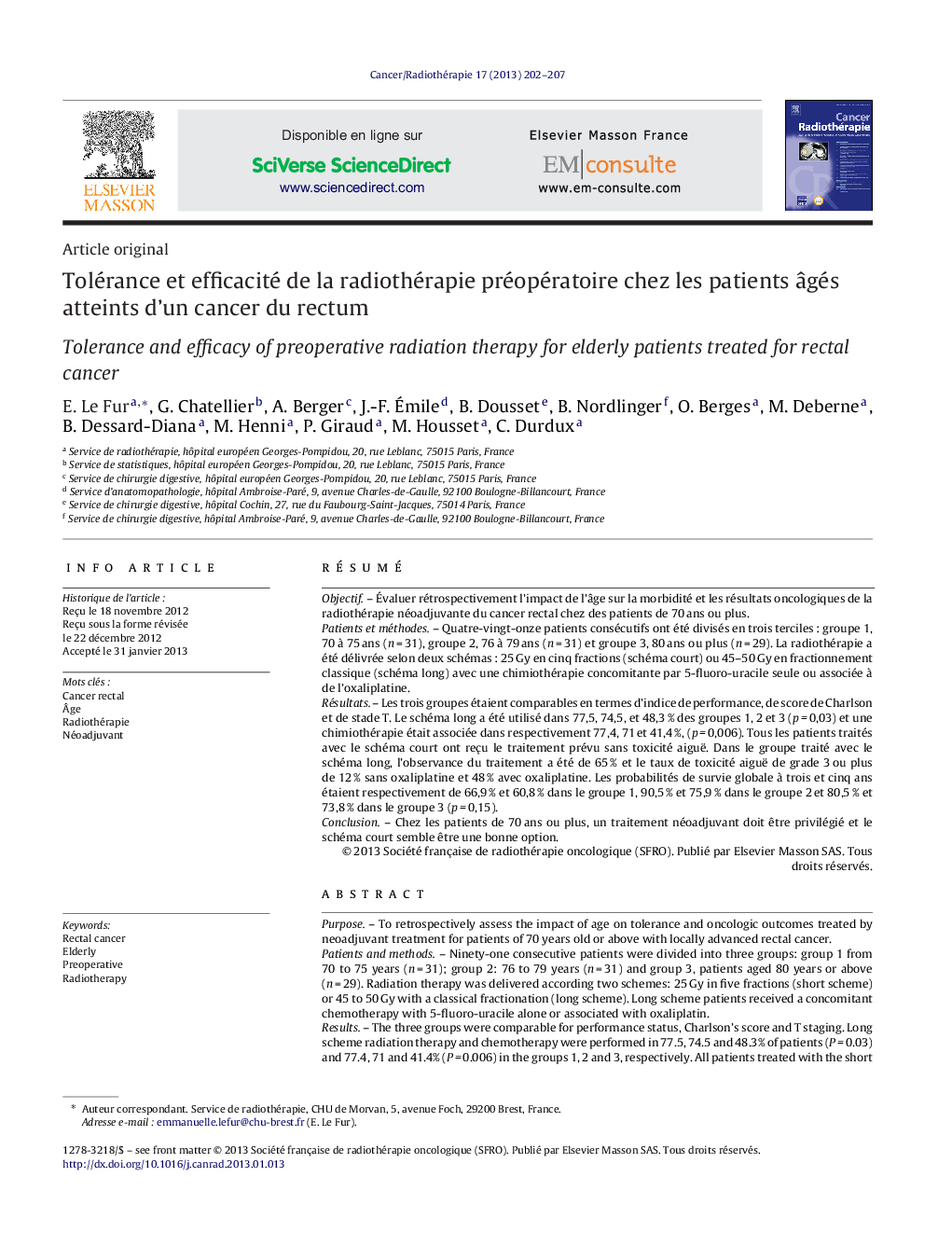| Article ID | Journal | Published Year | Pages | File Type |
|---|---|---|---|---|
| 2117216 | Cancer/Radiothérapie | 2013 | 6 Pages |
RésuméObjectifÉvaluer rétrospectivement l’impact de l’âge sur la morbidité et les résultats oncologiques de la radiothérapie néoadjuvante du cancer rectal chez des patients de 70 ans ou plus.Patients et méthodesQuatre-vingt-onze patients consécutifs ont été divisés en trois terciles : groupe 1, 70 à 75 ans (n = 31), groupe 2, 76 à 79 ans (n = 31) et groupe 3, 80 ans ou plus (n = 29). La radiothérapie a été délivrée selon deux schémas : 25 Gy en cinq fractions (schéma court) ou 45–50 Gy en fractionnement classique (schéma long) avec une chimiothérapie concomitante par 5-fluoro-uracile seule ou associée à de l’oxaliplatine.RésultatsLes trois groupes étaient comparables en termes d’indice de performance, de score de Charlson et de stade T. Le schéma long a été utilisé dans 77,5, 74,5, et 48,3 % des groupes 1, 2 et 3 (p = 0,03) et une chimiothérapie était associée dans respectivement 77,4, 71 et 41,4 %, (p = 0,006). Tous les patients traités avec le schéma court ont reçu le traitement prévu sans toxicité aiguë. Dans le groupe traité avec le schéma long, l’observance du traitement a été de 65 % et le taux de toxicité aiguë de grade 3 ou plus de 12 % sans oxaliplatine et 48 % avec oxaliplatine. Les probabilités de survie globale à trois et cinq ans étaient respectivement de 66,9 % et 60,8 % dans le groupe 1, 90,5 % et 75,9 % dans le groupe 2 et 80,5 % et 73,8 % dans le groupe 3 (p = 0,15).ConclusionChez les patients de 70 ans ou plus, un traitement néoadjuvant doit être privilégié et le schéma court semble être une bonne option.
PurposeTo retrospectively assess the impact of age on tolerance and oncologic outcomes treated by neoadjuvant treatment for patients of 70 years old or above with locally advanced rectal cancer.Patients and methodsNinety-one consecutive patients were divided into three groups: group 1 from 70 to 75 years (n = 31); group 2: 76 to 79 years (n = 31) and group 3, patients aged 80 years or above (n = 29). Radiation therapy was delivered according two schemes: 25 Gy in five fractions (short scheme) or 45 to 50 Gy with a classical fractionation (long scheme). Long scheme patients received a concomitant chemotherapy with 5-fluoro-uracile alone or associated with oxaliplatin.ResultsThe three groups were comparable for performance status, Charlson's score and T staging. Long scheme radiation therapy and chemotherapy were performed in 77.5, 74.5 and 48.3% of patients (P = 0.03) and 77.4, 71 and 41.4% (P = 0.006) in the groups 1, 2 and 3, respectively. All patients treated with the short scheme irradiation received the treatment without any acute toxicity. In the long scheme group, 65% of patients received the treatment on time and grade 3 or above toxicity was observed in 12% of patients who did not receive oxaliplatin and in 48% of patients who received oxaliplatin. The overall survival rate at 3 and 5 years was 66.9% and 60.8% in the group 1, 90.5% and 75.9% in the group 2 and 80.5% and 73.8% in the group 3 (P = 0.15).ConclusionNeoadjuvant treatment is feasible with encouraging survival rates for patients aged 70 years and older. Short scheme radiation therapy seems to be an interesting option in this population.
